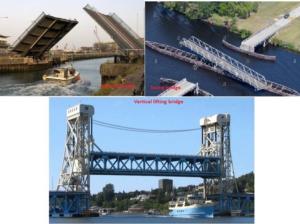atOptions = {
'key' : 'e711ed0b9e2c20ede149c064e74f7e6d',
'format' : 'iframe',
'height' : 90,
'width' : 728,
'params' : {}
};
Types of Bridges According to its Spans & Flexibility
Bridges play an essential role in the development of any country. There are various types of bridges used in transportation engineering. The bridge must be stiff enough to resist movement. Each member of the bridge is made to withstand the load which is placed or moving upon it.
The Bridges are classified into different types according to,
- The flexibility of the structure
- Inter-span
- superstructure
- The length of the span as culvert
- Based on utility
- Based on the high flood level
According to the flexibility of the structure:
1: Fixed span bridge:
- Fixed bridges are having no moving parts and stay in one place until they fail or are demolished.
- They are designed to stay where they are made to the point they are unusable or demolished.
2: Movable span bridge:
- The movable bridge having consisted of moveable decks and most often powered by electricity.
- The superstructure of the bridge can be moved or lifted with the help of a suitable arrangement.

According to inter-span:
1: Supported:
- In a supported bridge, the bridge’s width is divide into the number of individual spans.
- For each span in the supported bridge, the member load is may supported at both ends.
- In these types of bridge plates and truss, the girder will be used.
2: Continuous bridge:
- The spans are continuous over the two or more than two supports.
- The stresses have reduced constantly due to the negative bending moments developed at the piers and abutments.
- In this type of bridge, the bending moment in the span is less than the supported bridge.
3: Cantilever bridge:
- Cantilever bridge only supported at one end, and another end is free to space.
- Generally, we are joined two cantilever portions to make way for vehicles and humans.
According to superstructure:
1: Suspension Bridge:
- The most expensive bridge type is too strong and its span long distance such as across river.
- The main element is suspension cables stretching over two towers and can be attached at each end to another deep in the ground.
- The span over 500 m up to 1400 m.
- Vertical smaller suspension cables are connected to the main wires to support the deck below.
2: Beam Bridges:
- These are the oldest and most specific types of bridges consisting of vertical piers and horizontal beams.
- It is suitable for only a short span but can be used for more extensive crossing by adding additional piers.
- Span up to 10 to
- Beam bridges are easy to built and inexpensive than other bridge types, but they have a limited span.
3: Truss bridge:
- It consists of an assembly of triangles and is commonly made from a series of straight steel bars.
- Supported the span up to 30 to 375 m.
- In cantilever, span up to 550 m.
- Rigid arms extend from both sides of the two piers. Diagonal steel tubes projecting from the top and bottom of each port hold the arms in the place like a strong diving board called cantilever arms.
- The Truss bridge is powerful, and it can support heavy loads.
4: Arch bridge:
- The arch bridge is looking like same a curved shape bridge.
- In this bridge, the horizontal thrust is developed.
- The abutments restrain an arch bridge at each end of the bridge.
- For masonry, span up to 3 to 15 m.
- Steel, span up to 519 m.
- Concrete, span up to 305 m.
According to the length of the span as culvert:
1: Minor bridge:
- The total span length of the bridge is greater than 6 m, and less than 60 m is called the minor bridge.
2: Long-span bridge:
- The total span length of the bridge is more than 120 m is called the long-span bridge.
3: Culvert bridge:
- A culvert is a small bridge with a total length of 6 m or less than the 6 m between the abutment faces called a trench.
According to based on utility:
1: Temporary bridge:
- The temporary bridge is a low-cost bridge.
- It is necessary where the construction of dams or bridges or during floods.
- After the construction of the original bridge structure then temporary bridges are removed or dismantle.
2: Permanent bridge:
- Permanent bridges are constructed for an extended period of use.
- Permanent bridges are maintained at a high level.
According to based on high flood level:
1: Low-level bridge:
- The superstructure of the low-level bridge is below the high-level flood.
- When floods, these bridges are submerged in water.
- These types of bridges are constructed for unimportant routes at a low cost.
2: High-level bridge:
- When floods occur at a high level, bridges are not submerged in water.
- These types of bridges are constructed for essential routes.
Read Also:-
We Love Cricket
atOptions = {
'key' : 'e711ed0b9e2c20ede149c064e74f7e6d',
'format' : 'iframe',
'height' : 90,
'width' : 728,
'params' : {}
};
